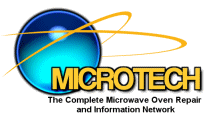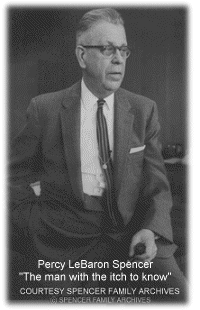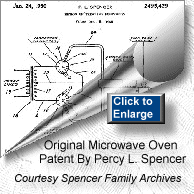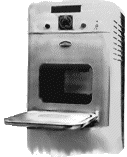 |

|
|
| Complete Video Course on 2-Hour DVD with Info-Packed Bonus CD-ROM |
||
Who Invented Microwaves? |
||
 |

|
|
| Complete Video Course on 2-Hour DVD with Info-Packed Bonus CD-ROM |
||
Who Invented Microwaves? |
||
Of course, asking "Who Invented Microwaves?" is like asking who invented electricity. Microwave energy is a natural phenomenon that occurs when electric current flows through a conductor. Microwaves are a form of electromagnetic radiation that is very similar to sunlight and radio waves.
A Brief History of the Microwave Oven |
|
 Like
many of today's great inventions, the microwave oven was a by-product of
another technology. It was during a radar-related research project around
1946 that Dr. Percy Spencer, a Like
many of today's great inventions, the microwave oven was a by-product of
another technology. It was during a radar-related research project around
1946 that Dr. Percy Spencer, a self-taught engineer with the Raytheon Corporation, noticed something very
unusual. He was testing a new vacuum tube called a magnetron
(we are searching for a picture of an actual 1946 magnetron), when he discovered
that the candy bar in his pocket had melted. This intrigued Dr. Spencer,
so he tried another experiment. This time he placed some popcorn kernels
near the tube and, perhaps standing a little farther away, he watched with
an inventive sparkle in his eye as the popcorn sputtered, cracked and popped
all over his lab.
self-taught engineer with the Raytheon Corporation, noticed something very
unusual. He was testing a new vacuum tube called a magnetron
(we are searching for a picture of an actual 1946 magnetron), when he discovered
that the candy bar in his pocket had melted. This intrigued Dr. Spencer,
so he tried another experiment. This time he placed some popcorn kernels
near the tube and, perhaps standing a little farther away, he watched with
an inventive sparkle in his eye as the popcorn sputtered, cracked and popped
all over his lab. |
|

The next morning, Scientist Spencer decided to put the magnetron tube near an egg. Spencer was joined by a curious colleague, and they both watched as the egg began to tremor and quake. The rapid temperature rise within the egg was causing tremendous internal pressure. Evidently the curious colleague moved in for a closer look just as the egg exploded and splattered hot yolk all over his amazed face. The face of Spencer lit up with a logical scientific conclusion: the melted candy bar, the popcorn, and now the exploding egg, were all attributable to exposure to low-density microwave energy. Thus, if an egg can be cooked that quickly, why not other foods? Experimentation began... Dr. Spencer fashioned a metal box
with an opening into which he fed microwave power. The energy entering
the box was unable to escape, thereby creating a higher density electromagnetic
field. When food was placed in the box and microwave energy fed in, the
temperature of the food rose very rapidly. Dr. Spencer had invented what
was to revolutionize cooking, and form the basis of a multimillion dollar
industry, the microwave oven. Nearly 6 Feet Tall, Weighing 750 PoundsEngineers went to work on Spencer's hot new idea, developing and refining it for practical use. By late 1946, the Raytheon Company had filed a patent proposing that microwaves be used to cook food. An oven that heated food using microwave energy was then placed in a Boston restaurant for testing. At last, in 1947, the first commercial microwave oven hit the market. These primitive units where gigantic and enormously expensive, standing 5 1/2 feet tall, weighing over 750 pounds, and costing about $5000 each. The magnetron tube had to be water-cooled, so plumbing installations were also required. |
 |
 |
Initial Reactions Were UnfavorableNot surprisingly, many were highly reluctant about these first units, and so they found only limited acceptance. Initial sales were disappointing...but not for long. Further improvements and refinements soon produced a more reliable and lightweight oven that was not only less expensive, but, with the development of a new air-cooled magnetron, there was no longer any need for a plumber.The microwave oven had reached a new level of acceptance, particularly with regard to certain industrial applications. By having a microwave oven available, restaurants and vending companies could now keep products refrigerator-fresh up to the point of service, then heat to order. The result? Fresher food, less waste, and money saved. |
As the food industry began to recognize the potential and versatility of the microwave oven, its usefulness was put to new tests. Industries began using microwaves to dry potato chips and roast coffee beans and peanuts. Meats could be defrosted, precooked and tempered. Even the shucking of oysters was made easier by microwaves. Other industries found the diverse applications of microwave heating quite advantageous. In time, microwaves were being used to dry cork, ceramics, paper, leather, tobacco, textiles, pencils, flowers, wet books and match heads. The microwave oven had become a necessity in the commercial market and the possibilities seemed endless.
The First "Radarange"
 In
1947, Raytheon demonstrated the world's first microwave oven and called it a
"Radarange," the winning name in an employee contest. Housed in refrigerator-sized
cabinets, the first microwave ovens cost between $2,000 and $3,000. Sometime
between 1952-55, Tappan introduced the first home model priced at $1295. In
1965 Raytheon acquired Amana Refrigeration. Two years later, the first countertop,
domestic oven was introduced. It was a 100-volt microwave oven, which cost just
under $500 and was smaller, safer and more reliable than previous models.
In
1947, Raytheon demonstrated the world's first microwave oven and called it a
"Radarange," the winning name in an employee contest. Housed in refrigerator-sized
cabinets, the first microwave ovens cost between $2,000 and $3,000. Sometime
between 1952-55, Tappan introduced the first home model priced at $1295. In
1965 Raytheon acquired Amana Refrigeration. Two years later, the first countertop,
domestic oven was introduced. It was a 100-volt microwave oven, which cost just
under $500 and was smaller, safer and more reliable than previous models.
By 1975, sales of microwave ovens would, for the first time, exceed that of gas ranges. The following year, a reported 17% of all homes in Japan were doing their cooking by microwaves, compared with 4% of the homes in the United States the same year. Before long, though, microwave ovens were adorning the kitchens in over nine million homes, or about 14%, of all the homes in the United States. In 1976, the microwave oven became a more commonly owned kitchen appliance than the dishwasher, reaching nearly 60%, or about 52 million U.S. households. America's cooking habits were being drastically changed by the time and energy-saving convenience of the microwave oven. Once considered a luxury, the microwave oven had developed into a practical necessity for a fast-paced world.
An expanding market has produced a style to suit every taste; a size, shape, and color to fit any kitchen, and a price to please almost every pocketbook. Options and features, such as the addition of convection heat, probe and sensor cooking, meet the needs of virtually every cooking, heating or drying application. Today, the magic of microwave cooking has radiated around the globe, becoming an international phenomenon.
On September 18, 1999, Dr. Percy LaBaron Spencer was inducted into the National Inventors Hall of Fame and took his place in history alongside such great inventors as Thomas Edison, the Wright Brothers and George Washington Carver.
Click HERE:
1958 Issue of Readers Digest article about Dr. Percy Spencer More to come on the fascinating history
and development of the microwave oven...
Note: Photo of Percy Spencer and
Patent provided courtesy of The Spencer Family Archives
Click HERE:
Wikiverse - A World of Knowledge. Article about Percy Spencer
with additional links.
Picture of the earliest microwave oven provided courtesy of The Lemelson-MIT
Awards Program's Invention Dimension web site, http://web.mit.edu/invent
![]()
More about the myths
& mysteries of microwave ovens ![]()
| | Back | Send Email | Home Page | Microwave CD-ROM| |
All materials appearing on this website may not be reproduced, stored in any retrieval system, or used in any way for commercial purposes without the express prior written permission of the copyright holder.
Send correspondence to: Microtech, P.O. Box 940, Gonzalez, Florida 32560
Disclaimer: The author assumes no liability for any incidental, consequential or other liability from the use of this information. All risks and damages, incidental or otherwise, arising from the use or misuse of the information contained herein are entirely the responsibility of the user. Although careful precaution has been taken in the preparation of this material, we assume no responsibility for omissions or errors.